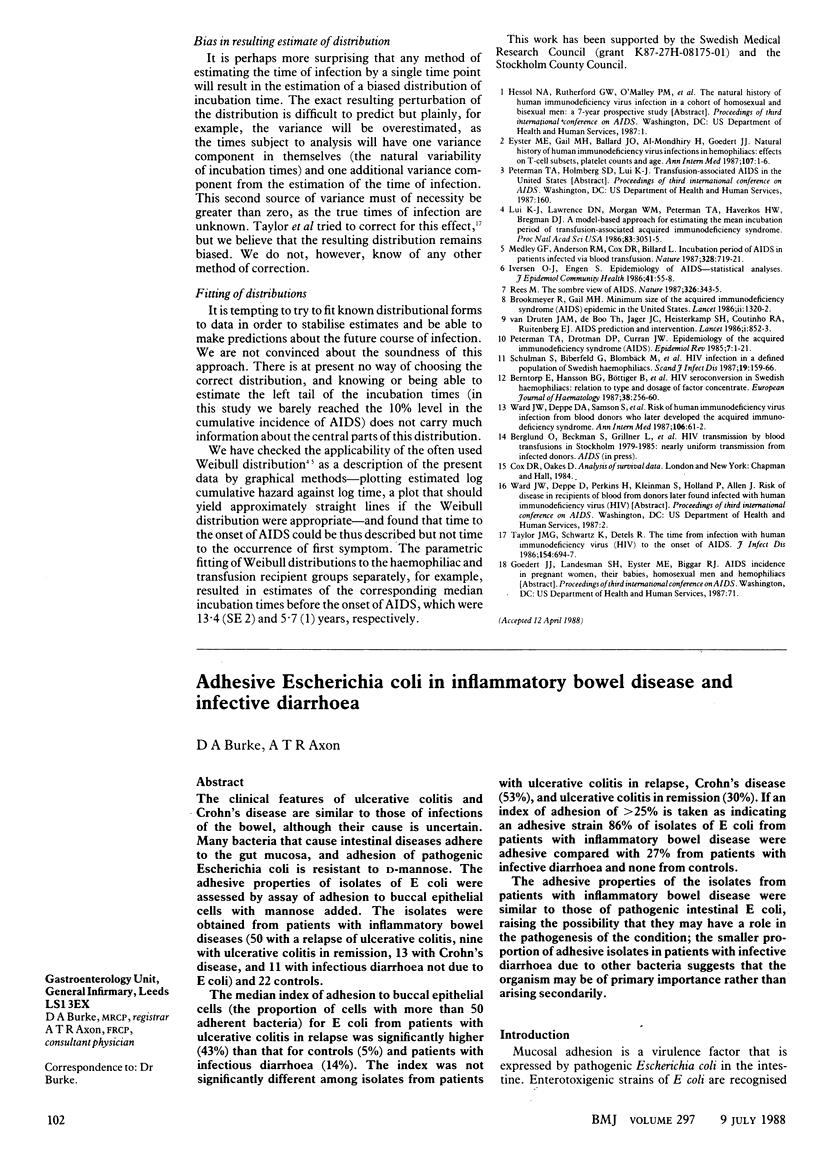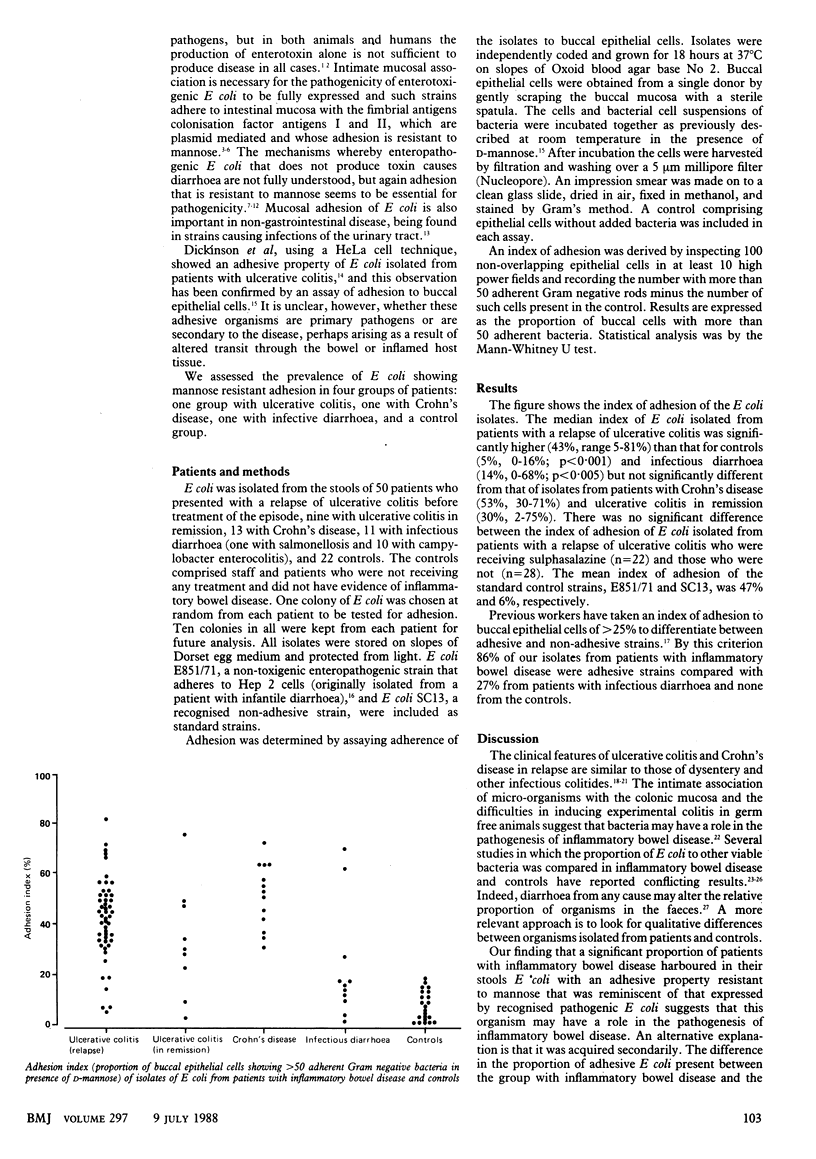Abstract
The clinical features of ulcerative colitis and Crohn's disease are similar to those of infections of the bowel, although their cause is uncertain. Many bacteria that cause intestinal diseases adhere to the gut mucosa, and adhesion of pathogenic Escherichia coli is resistant to D-mannose. The adhesive properties of isolates of E coli were assessed by assay of adhesion to buccal epithelial cells with mannose added. The isolates were obtained from patients with inflammatory bowel diseases (50 with a relapse of ulcerative colitis, nine with ulcerative colitis in remission, 13 with Crohn's disease, and 11 with infectious diarrhoea not due to E coli) and 22 controls. The median index of adhesion to buccal epithelial cells (the proportion of cells with more than 50 adherent bacteria) for E coli from patients with ulcerative colitis in relapse was significantly higher (43%) than that for controls (5%) and patients with infectious diarrhoea (14%). The index was not significantly different among isolates from patients with ulcerative colitis in relapse, Crohn's disease (53%), and ulcerative colitis in remission (30%). If an index of adhesion of greater than 25% is taken as indicating an adhesive strain 86% of isolates of E coli from patients with inflammatory bowel disease were adhesive compared with 27% from patients with infective diarrhoea and none from controls. The adhesive properties of the isolates from patients with inflammatory bowel disease were similar to those of pathogenic intestinal E coli, raising the possibility that they may have a role in the pathogenesis of the condition; the smaller proportion of adhesive isolates in patients with infective diarrhoea due to other bacteria suggests that the organism may be of primary importance rather than arising secondarily.
Full text
PDF


Images in this article
Selected References
These references are in PubMed. This may not be the complete list of references from this article.
- Berglund G., Sannerstedt R., Andersson O., Wedel H., Wilhelmsen L., Hansson L., Sivertsson R., Wikstrand J. Coronary heart-disease after treatment of hypertension. Lancet. 1978 Jan 7;1(8054):1–5. doi: 10.1016/s0140-6736(78)90356-2. [DOI] [PubMed] [Google Scholar]
- Blaser M. J., Berkowitz I. D., LaForce F. M., Cravens J., Reller L. B., Wang W. L. Campylobacter enteritis: clinical and epidemiologic features. Ann Intern Med. 1979 Aug;91(2):179–185. doi: 10.7326/0003-4819-91-2-179. [DOI] [PubMed] [Google Scholar]
- Burke D. A., Axon A. T. Ulcerative colitis and Escherichia coli with adhesive properties. J Clin Pathol. 1987 Jul;40(7):782–786. doi: 10.1136/jcp.40.7.782. [DOI] [PMC free article] [PubMed] [Google Scholar]
- Candy D. C., Leung T. S., Phillips A. D., Harries J. T., Marshall W. C. Models for studying the adhesion of enterobacteria to the mucosa of the human intestinal tract. Ciba Found Symp. 1981;80:72–93. doi: 10.1002/9780470720639.ch6. [DOI] [PubMed] [Google Scholar]
- Cooke E. M. A quantitative comparison of the faecal flora of patients with ulcerative colitis and that of normal persons. J Pathol Bacteriol. 1967 Oct;94(2):439–444. doi: 10.1002/path.1700940225. [DOI] [PubMed] [Google Scholar]
- Cooke E. M., Ewins S. P., Hywel-Jones J., Lennard-Jones J. E. Properties of strains of Escherichia coli carried in different phases of ulcerative colitis. Gut. 1974 Feb;15(2):143–146. doi: 10.1136/gut.15.2.143. [DOI] [PMC free article] [PubMed] [Google Scholar]
- Dickinson R. J., Varian S. A., Axon A. T., Cooke E. M. Increased incidence of faecal coliforms with in vitro adhesive and invasive properties in patients with ulcerative colitis. Gut. 1980 Sep;21(9):787–792. doi: 10.1136/gut.21.9.787. [DOI] [PMC free article] [PubMed] [Google Scholar]
- Duguid J. P., Clegg S., Wilson M. I. The fimbrial and non-fimbrial haemagglutinins of Escherichia coli. J Med Microbiol. 1979 May;12(2):213–227. doi: 10.1099/00222615-12-2-213. [DOI] [PubMed] [Google Scholar]
- Evans D. G., Evans D. J., Jr, Tjoa W. S., DuPont H. L. Detection and characterization of colonization factor of enterotoxigenic Escherichia coli isolated from adults with diarrhea. Infect Immun. 1978 Feb;19(2):727–736. doi: 10.1128/iai.19.2.727-736.1978. [DOI] [PMC free article] [PubMed] [Google Scholar]
- Evans D. G., Silver R. P., Evans D. J., Jr, Chase D. G., Gorbach S. L. Plasmid-controlled colonization factor associated with virulence in Esherichia coli enterotoxigenic for humans. Infect Immun. 1975 Sep;12(3):656–667. doi: 10.1128/iai.12.3.656-667.1975. [DOI] [PMC free article] [PubMed] [Google Scholar]
- Gorbach S. L. Intestinal microflora. Gastroenterology. 1971 Jun;60(6):1110–1129. [PubMed] [Google Scholar]
- Gorbach S. L., Nahas L., Plaut A. G., Weinstein L., Patterson J. F., Levitan R. Studies of intestinal microflora. V. Fecal microbial ecology in ulcerative colitis and regional enteritis: relationship to severity of disease and chemotherapy. Gastroenterology. 1968 Apr;54(4):575–587. [PubMed] [Google Scholar]
- Keighley M. R., Arabi Y., Dimock F., Burdon D. W., Allan R. N., Alexander-Williams J. Influence of inflammatory bowel disease on intestinal microflora. Gut. 1978 Dec;19(12):1099–1104. doi: 10.1136/gut.19.12.1099. [DOI] [PMC free article] [PubMed] [Google Scholar]
- Knutton S., Lloyd D. R., Candy D. C., McNeish A. S. Adhesion of enterotoxigenic Escherichia coli to human small intestinal enterocytes. Infect Immun. 1985 Jun;48(3):824–831. doi: 10.1128/iai.48.3.824-831.1985. [DOI] [PMC free article] [PubMed] [Google Scholar]
- Levine M. M., Nataro J. P., Karch H., Baldini M. M., Kaper J. B., Black R. E., Clements M. L., O'Brien A. D. The diarrheal response of humans to some classic serotypes of enteropathogenic Escherichia coli is dependent on a plasmid encoding an enteroadhesiveness factor. J Infect Dis. 1985 Sep;152(3):550–559. doi: 10.1093/infdis/152.3.550. [DOI] [PubMed] [Google Scholar]
- McNeish A. S., Turner P., Fleming J., Evans N. Mucosal adherence of human enteropathogenic Escherichia coli. Lancet. 1975 Nov 15;2(7942):946–948. doi: 10.1016/s0140-6736(75)90360-8. [DOI] [PubMed] [Google Scholar]
- Onderdonk A. B., Bartlett J. G. Bacteriological studies of experimental ulcerative colitis. Am J Clin Nutr. 1979 Jan;32(1):258–265. doi: 10.1093/ajcn/32.1.258. [DOI] [PubMed] [Google Scholar]
- Orskov I., Orskov F. Episome-carried surface antigen K88 of Escherichia coli. I. Transmission of the determinant of the K88 antigen and influence on the transfer of chromosomal markers. J Bacteriol. 1966 Jan;91(1):69–75. doi: 10.1128/jb.91.1.69-75.1966. [DOI] [PMC free article] [PubMed] [Google Scholar]
- Rothbaum R., McAdams A. J., Giannella R., Partin J. C. A clinicopathologic study of enterocyte-adherent Escherichia coli: a cause of protracted diarrhea in infants. Gastroenterology. 1982 Aug;83(2):441–454. [PubMed] [Google Scholar]
- STEWART G. T. Post-dysenteric colitis. Br Med J. 1950 Feb 18;1(4650):405–409. doi: 10.1136/bmj.1.4650.405. [DOI] [PMC free article] [PubMed] [Google Scholar]
- Sansonetti P. J., Hale T. L., Dammin G. J., Kapfer C., Collins H. H., Jr, Formal S. B. Alterations in the pathogenicity of Escherichia coli K-12 after transfer of plasmid and chromosomal genes from Shigella flexneri. Infect Immun. 1983 Mar;39(3):1392–1402. doi: 10.1128/iai.39.3.1392-1402.1983. [DOI] [PMC free article] [PubMed] [Google Scholar]
- Satterwhite T. K., Evans D. G., DuPont H. L., Evans D. J., Jr Role of Escherichia coli colonisation factor antigen in acute diarrhoea. Lancet. 1978 Jul 22;2(8082):181–184. doi: 10.1016/s0140-6736(78)91921-9. [DOI] [PubMed] [Google Scholar]
- Smith H. W., Linggood M. A. Observations on the pathogenic properties of the K88, Hly and Ent plasmids of Escherichia coli with particular reference to porcine diarrhoea. J Med Microbiol. 1971 Nov;4(4):467–485. doi: 10.1099/00222615-4-4-467. [DOI] [PubMed] [Google Scholar]
- Takeda Y., Honda T., Sima H., Tsuji T., Miwatani T. Analysis of antigenic determinants in cholera enterotoxin and heat-labile enterotoxins from human and porcine enterotoxigenic Escherichia coli. Infect Immun. 1983 Jul;41(1):50–53. doi: 10.1128/iai.41.1.50-53.1983. [DOI] [PMC free article] [PubMed] [Google Scholar]
- Tedesco F. J., Hardin R. D., Harper R. N., Edwards B. H. Infectious colitis endoscopically simulating inflammatory bowel disease: a prospective evaluation. Gastrointest Endosc. 1983 Aug;29(3):195–197. doi: 10.1016/s0016-5107(83)72583-6. [DOI] [PubMed] [Google Scholar]
- Ulshen M. H., Rollo J. L. Pathogenesis of escherichia coli gastroenteritis in man--another mechanism. N Engl J Med. 1980 Jan 10;302(2):99–101. doi: 10.1056/NEJM198001103020207. [DOI] [PubMed] [Google Scholar]
- Vantrappen G., Ponette E., Geboes K., Bertrand P. Yersinia enteritis and enterocolitis: gastroenterological aspects. Gastroenterology. 1977 Feb;72(2):220–227. [PubMed] [Google Scholar]
- Williams P. H., Sedgwick M. I., Evans N., Turner P. J., George R. H., McNeish A. S. Adherence of an enteropathogenic strain of Escherichia coli to human intestinal mucosa is mediated by a colicinogenic conjugative plasmid. Infect Immun. 1978 Nov;22(2):393–402. doi: 10.1128/iai.22.2.393-402.1978. [DOI] [PMC free article] [PubMed] [Google Scholar]
- van der Wiel-Korstanje J. A., Winkler K. C. The faecal flora in ulcerative colitis. J Med Microbiol. 1975 Nov;8(4):491–501. doi: 10.1099/00222615-8-4-491. [DOI] [PubMed] [Google Scholar]



